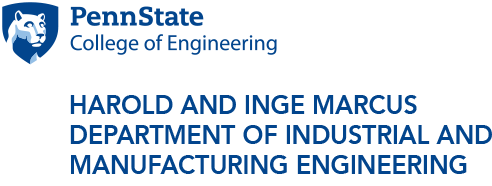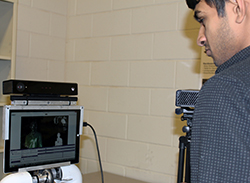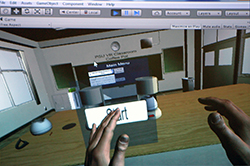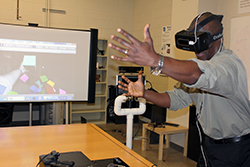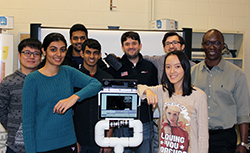
Owen Shartle (senior, computer science and engineering) views a digital version of his hands in the immersive virtual reality classroom environment designed in the Design Analysis Technology Advancement (DATA) Lab.
Tucker receives funding to teach engineering in a virtual environment
1/22/2016
UNIVERSITY PARK, Pa. — Conrad Tucker, assistant professor of engineering design and industrial engineering and an affiliate faculty member of computer science and engineering, is the principal investigator of one of four proposals selected by Penn State’s Center for Online Innovation in Learning (COIL) to receive research dollars through its Research Initiation Grant Program. A total of 30 proposals were submitted to COIL for this new funding program.
The proposal, titled “VR Penn State: Teaching Engineering Concepts in an Immerse Virtual Reality Environment,” is supported by co-investigators Chimay Anumba, professor and head of the Department of Architectural Engineering; Sven Bilén, professor and head of the School of Engineering Design, Technology and Professional Programs and professor of electrical engineering and aerospace engineering; and Janis Terpenny, professor and Peter and Angela Dal Pezzo Chair and Department Head of the Harold and Inge Marcus Department of Industrial and Manufacturing Engineering.
“The outcomes of this research have the potential to provide a scalable learning environment to online learners that will transform virtual collaboration from passive experiences in which students simply consume content, to more interactive experiences in which students communicate by creating and augmenting content in a collaborative manner,” said Tucker.
Online educational platforms, such as Penn State’s World Campus, have expanded the access to high quality education beyond the physical boundaries of the State College, Pennsylvania area, explained Tucker. However, a fundamental limitation of online learning environments is the absence of real-time, immersive interactions during online classroom instruction.
“Through this research, we will demonstrate the feasibility of creating an immersive, interactive online experience that is capable of teaching core engineering concepts to an entire class of students at Penn State,” explained Tucker.
The researchers will be looking at two important questions through their work: are there differences in learning outcomes between learners in traditional brick and mortar environments versus those in immersive VR environments when engaged in tangible interactions, such as prototype creation or similar hands-on projects? And are there differences in learning outcomes between students in brick and mortar environments versus those in immersive VR environments when engaged in intangible interactions, such as teamwork?
In looking at tangible interactions which involve the creation of tangible models, such as prototypes or design solutions, students will be able to interact with an immersive 3D environment and also utilize objects in the environment to create and test resulting prototypes using natural hand gestures through the use of VR technology.
How will this VR environment be created? A 3D scan of an engineering classroom will be taken and a 3D mesh of the room will be made through the use of RGB-D sensing systems. This mesh is essentially a virtual tour of the classroom, including furniture, models, computers, whiteboards and anything else that is present in engineering learning spaces.
“This will essentially allow students who are learning from a distance to have the feeling of being in the same classroom and workspace area as those who are physically in one of the engineering classrooms or labs on campus,” said Tucker.
Students will use an Oculus Rift device that is fitted with Leap Motion technology so they can literally see the 3D interaction their hands have on a virtual object.
“Through the use of an Oculus Rift headset retrofitted with a Leap Motion sensor, students will be able to use their hands to rotate, explore and dissect a virtual model the same way a traditional student would explore a physical object or prototype with his or her hands,” said Tucker.
As for intangible interactions in the classroom, which involve the communication of concepts or ideas, students will be able to use the VR environment to create and augment how intangible/abstract concepts are communicated.
Researchers will then compare the effectiveness of each setting by testing students who were physically present in several engineering courses—including engineering design, industrial engineering and architectural engineering courses—versus students who were learning the concepts from a distance through the VR environment.
“Given the variations that exist in hardware systems—such as computers, tablets and cell phones—and also in network capabilities—DSL and broadband—we will be able to identify the learning outcomes that are better suited for brick and mortar learning versus the learning outcomes that are better suited for online learning environments due to the ability of immersive virtual reality systems to scale and efficiently mimic brick and mortar learning,” said Tucker.
The research team has received $38,745 for the yearlong project which will provide the pilot data and research publications needed to compete for larger external funding from federal agencies (such as the National Science Foundation) in the fall.
The following engineering students are assisting with this research project: Shruthi Bezawada (graduate student, industrial engineering); Matthew Dering (graduate student, computer science and engineering); Qianyu Hu (graduate student, industrial engineering); Kevin Lesniak (graduate student, computer science and engineering); Sunghoon Lim (graduate student, industrial engineering); Adam Mohammed (senior, aerospace engineering); Owen Shartle (senior, computer science and engineering); and Abhinav Singh (graduate student, industrial engineering).

